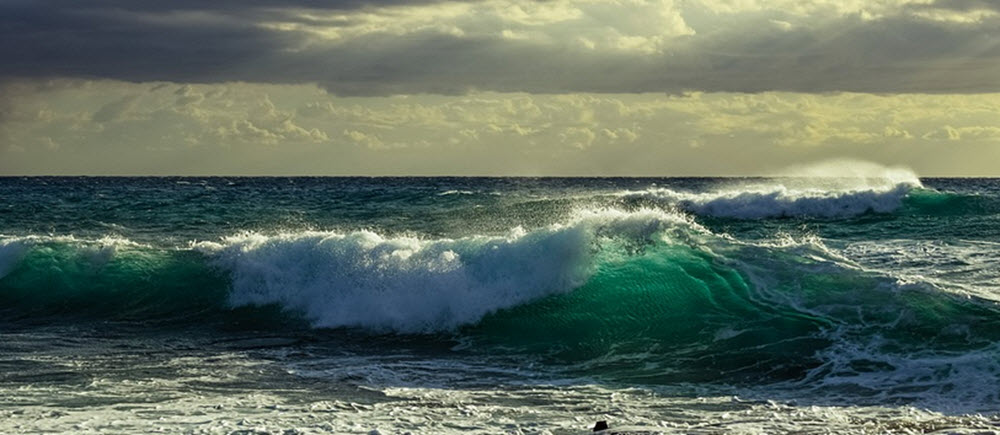Contents
Wave power plants in the ocean convert the kinetic energy of sea waves into electricity. The energy can also be utilized for desalination and pumping of water without first being converted into electricity.
For every meter of wave along a shore, the energy density of the wave is 30 kW – 40 kW. Ultimately, waves are produced using energy from the sun.

Examples of wave power plants
Sotenäs
The Sotenäs wave farm is located off the coast of western Sweden, not far from the Norwegian border. It began generating electricity on 14 January 2016. The facility consists of 36 wave energy converters with a total capacity of almost 3 MW. The technology used encompasses point absorber buoys and linear generators. The generators have been placed on the seabed, at a depth of 50 meters.
The Mutriku Breakwater Wave Plant
Located in the Bay of Biscay, this is the world´s first breakwater wave power plant with a multiple turbine arrangement. It was built by Ente Vasco de la Energía and opened on 8 July 2011, near the city of Mutriku in the Autonomous Community of Basque Country. The Mutriku Breakwater Wave Plant has 16 turbo generator sets and a capacity of 296 kW. The technology used is oscillating water column (OWC).
Azura
Azura is a wave power device connected to the municipal grid of Hawaii. So far, it is still in a testing stage, but the plan is to use information gathered during the testing stage to to further develop the project. The device is located on the northern shore of Kaneohe Bay, Oahu, on the surface of a 30 meter deep berth. Azura can generate 20 kilowatts of power.
Wave power technology
The five main types of wave power technology:
- Absorbers
- Attenuators
- Oscillation Water Columns
- Overtopping
- Inverted-Pendulum device
Absorbers
A buoy is moved by the rise and fall of the waves, and the absorber absorbs and extracts energy from these movements. That energy is then converted into electricity using a linear generator or a rotary generator.
Attenuators
The attenuator is placed perpendicular to the length of the wave, where it will flex where its segments are connected. The attenuators are connected to hydraulic pumps which convert the energy into electricity.
Oscillation Water Columns (OWC)
Oscillation Water Columns (OWC) is a partially submerged structure. The upper part is above water and the lower part is below. The upper part is air-filled, and incoming waves will be funnelled into the bottom part. Water moving through the structure causes the water column to rise and fall (in conjunction with the waves) and this pressurizes and depressurizes the air in the top part. The pressurizing and depressurizing pushes and pulls air through an air turbine that´s connected to the structure, and this is how electricity is generated in this type of device.
Overtopping
An overtopping device is, in essence, very similar to a traditional hydropower dam. The wave lifts over a barrier, which fills a reservoir with the water. The water is then drained through a hydro turbine and electricity is generated.
Inverted-Pendulum device
This device lets the waves move a hinged paddle. The paddle is designed in a way that allows it to move both forth and back. The motion of the paddle drives a hydraulic pump, which in turn drives a generator that produces electricity.
Background
In the 1790s, Monsieur Girard and his son proposed using direct mechanical wave action to power heavy machineries, such as pumps, mills and saws, and they receive a patent in Paris, France in 1799.
In 1910, Bochaux Praceique, also in France, developed a device capable of using wave power to light and power his house.
Another pioneer in the field was the Japanese naval commander Yoshio Masuda, who experimented with a variety of wave-energy devices capable of powering navigation lights at sea. He is commonly hailed as the father of modern wave power technology.